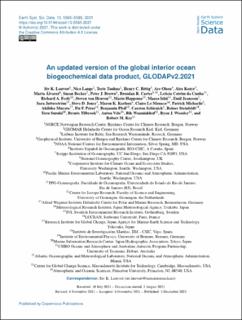| dc.contributor.author | Lauvset, Siv Kari | |
| dc.contributor.author | Lange, Nico | |
| dc.contributor.author | Tanhua, Toste | |
| dc.contributor.author | Bittig, Henry C. | |
| dc.contributor.author | Olsen, Are | |
| dc.contributor.author | Kozyr, Alex | |
| dc.contributor.author | Alvarez, Marta | |
| dc.contributor.author | Becker, Susan | |
| dc.contributor.author | Brown, Pete | |
| dc.contributor.author | Carter, Brendan R. | |
| dc.contributor.author | Da Cunha, Leticia Cotrim | |
| dc.contributor.author | Feely, Richard A | |
| dc.contributor.author | van Heuven, Steven | |
| dc.contributor.author | Hoppema, Mario | |
| dc.contributor.author | Ishii, Masao | |
| dc.contributor.author | Jeansson, Emil | |
| dc.contributor.author | Jutterström, Sara | |
| dc.contributor.author | Jones, Stephen Daniel | |
| dc.contributor.author | Karlsen, Maren Kjos | |
| dc.contributor.author | Monaco, Claire Lo | |
| dc.contributor.author | Michaelis, Patrick | |
| dc.contributor.author | Murata, Akihiko | |
| dc.contributor.author | Perez, Fiz F | |
| dc.contributor.author | Pfeil, Gerrit Benjamin | |
| dc.contributor.author | Schirnick, Carsten | |
| dc.contributor.author | Steinfeldt, Reiner | |
| dc.contributor.author | Suzuki, Toru | |
| dc.contributor.author | Tilbrook, Bronte | |
| dc.contributor.author | Velo, Antón | |
| dc.contributor.author | Wanninkhof, Rik | |
| dc.contributor.author | Woosley, Ryan J. | |
| dc.contributor.author | Key, Robert M. | |
| dc.date.accessioned | 2022-03-16T08:46:33Z | |
| dc.date.available | 2022-03-16T08:46:33Z | |
| dc.date.created | 2022-01-24T09:14:43Z | |
| dc.date.issued | 2021 | |
| dc.identifier.citation | Earth System Science Data. 2021, 13 (12), 5565-5589. | en_US |
| dc.identifier.issn | 1866-3508 | |
| dc.identifier.uri | https://hdl.handle.net/11250/2985409 | |
| dc.description.abstract | Mathematical models were developed to predict biomass and hydrocarbon productivities and colony size (ouputs) of Botryococcus braunii showa cultures based on light intensity, temperature and dilution rate (inputs). These models predicted the following maximum values: biomass productivity, 1.3 g L−1 d−1; hydrocarbon productivity, 1.5 mg L−1 d−1; colony size, 320 µm under different culture conditions respectively. These values were confirmed experimentally. Additionally, the combination of inputs that simultaneously maximize all the possible outputs combinations were determined. The prediction for biomass-hydrocarbon-colony size were 1 g L−1 d−1, 12.05 mg L−1 d−1 and 156.8 µm respectively; biomass productivity-hydrocarbon productivities: 1 g L−1 d−1 and 13.94 mg L−1 d−1 respectively; biomass productivity-colony size: 1 g L−1 d−1 and 172.8 µm respectively; hydrocarbon productivity-colony size: 9 mg L−1 d−1 and 240 µm respectively. All these predictions were validated experimentally. These models might be very useful to implement a Botryococcus braunii showa large scale production. | en_US |
| dc.language.iso | eng | en_US |
| dc.rights | Navngivelse 4.0 Internasjonal | * |
| dc.rights.uri | http://creativecommons.org/licenses/by/4.0/deed.no | * |
| dc.title | An updated version of the global interior ocean biogeochemical data product, GLODAPv2.2021 | en_US |
| dc.type | Journal article | en_US |
| dc.type | Peer reviewed | en_US |
| dc.rights.holder | © Author(s) 2021 | en_US |
| dc.description.version | publishedVersion | en_US |
| cristin.ispublished | true | |
| cristin.fulltext | original | |
| cristin.qualitycode | 1 | |
| dc.identifier.doi | 10.5194/essd-13-5565-2021 | |
| dc.identifier.cristin | 1988232 | |
| dc.source.journal | Earth System Science Data | en_US |
| dc.source.volume | 13 | en_US |
| dc.source.issue | 12 | en_US |
| dc.source.pagenumber | 5565-5589 | en_US |
| dc.relation.project | EC/H2020/821001 | en_US |
| dc.relation.project | EC/H2020/862626 | en_US |
| dc.relation.project | NORCE Norwegian Research Centre AS: Internal funding | en_US |

